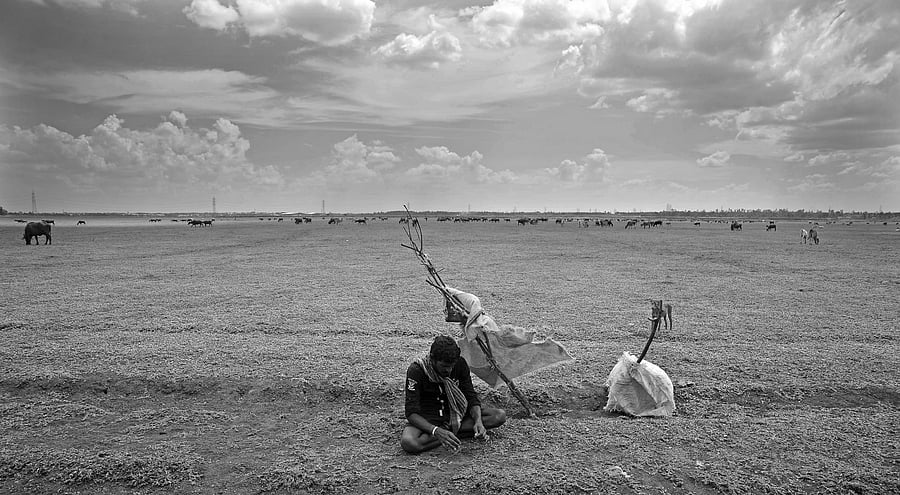

Officials in the city of Chennai continue to try and find alternative sources of water - but the community continues to pray for rain.
A man takes a dip as a bird searches for food on a parched lake bed in Chennai
Chennai consumes more than 500 million litres of water and the unprecedented water crisis this year has forced the state administration to source nature’s elixir even from sand quarries and private wells in neighbouring districts. To solve the crisis, a‘special water train’carrying 25 lakh litres of Cauvery water from Jollarpettai in Vellore district reached Chennai on July 12.Two trains with 50 wagons have been allotted by the Indian Railways for transporting the water and these trains will make four trips a day making the total amount of water to 11 million litres. A senior official with the Vellore district administration told DH that the water from the Cauvery River and other sources is collected at a particular spot and brought to the pumping station from where it is pumped to the Jollarpettai station.
A woman waits next to a truck of water cans near Besant Nagar
Academy Award-winning actor and environmental activist Leonardo DiCaprio highlighted the Chennai water crisis on his social media handle quoting a BBC article saying, "Only rain can save Chennai from this situation."
The metropolitan city needs 11 tmcft of water every year, which is 880 million litres of water (mld) per day. To fight the crisis, the Chennai Metro Rail Limited has reportedly begun turning off its air-conditioning to reduce water consumption. The government's Hindu Religious and Charitable Endowments Department (HR and CE), which administers over 44,000 temples in the state, has asked officials of important shrines to conduct special 'yagas' among other rituals for propitiating Lord Varuna, the God of rains.
Women carry water pots from a government water supply tanker near Egmore in Chennai
Residents of the metropolis are forced to wait on the streets for several hours a day for tankers carrying water.
Early this year, 24 districts, including Chennai, were declared drought-affected by the state government. CMWSSB has around 900 water tankers, each taking 10 trips, to supply water to the city. As on May 29, the combined water storage in four major lakes of Chembarambakkam, Poondi, Red Hills and Cholavaram that supply water to the city is 76 million cubic feet as against 2,964 mcft last year, according to the CMWSSB.
Children walk alongside the Red Hills reservoir
There may be plenty of reasons behind the crisis such as climate change, fast-growing population, industrialisation, the real estate boom, encroachments or mere negligence.
The delayed monsoon has exacerbated the problem. This June was the driest in the last five years. Farming operations have been affected in many parts of the country. There is also a shortage of water for daily use. Water levels of two-thirds of the reservoirs in the country are below normal levels. A failed, or deficient, monsoon will add to the miseries, as some areas are still reeling from the drought of last year.
Cholavaram Lake is one of the rain-fed reservoirs from where water is drawn to supply Chennai through Puzhal Lake
Chennai's crisis is a future reflection of many cities in the country that have to face water challenges.
Bengaluru with a severe shortage of potable water will go the Chennai way soon. Listing the grey areas that result in alarming levels of water pilferage, agroup of experts led by noted freedom fighter H S Doreswamy demanded immediate government action. Pointing out that the mega water projects like Yettinahole and plans to draw water from the Linganamakki Reservoir would eventually fail, they urged the government to make use of the plentiful rainfall that Bengaluru receives annually.
45-year-old Kumar waits in the center of Cholavaram Lake
As cattle graze on the parched lakebeds of Red Hills reservoir, Cholavarma Lake, Korattur Lake and others, the birds soak in the little water left in some of them.
The situation is worse in southern Tamil Nadu, where people are forced to wait for weeks for drinking water as the rain gods continue to play hide and seek with the lower riparian state.
Storks get a drink at Red Hills reservior
The animals and the birds have also been hit by the water scarcity.
Failure to curb usage and conserve water, destruction of lakes and wetlands, wrong urban planning and construction, over-extraction of groundwater and changes in land-use patterns have contributed to the present situation. Traditional water conservation methods and knowledge have been forgotten. Climate change has made the situation worse.
Water pipes are dry at Red Hills reservoir
The reservoirs that were the primary sources of drinking water for the city have dried up and some are infested with sewage that has drained into the lakes.
Chennai and the neighbouring Kancheepuram and Tiruvallur districts have over 3,000 large and small water bodies.It is imperative that concrete efforts are taken to bring a sustainable antidote to water scarcity in Tamil Nadu -- a state that had an abundance of water for everything from safe drinking to irrigation. If we examine the centuries-old water management system of Tamil Nadu, we find that these are among the best water management systems built in the world. Although built centuries ago, many still ponder how these water bodies were created and offered protection from the most severe droughts. Some of these are Kallanai Anaicut in Trichy, Kaalingarayan Canal in Bhavani-Erode, Uyyakondan Canal in Trichy and thousands of lakes.
Korattur Lake in Chennai has dried up
Several lakes in and around Chennai have almost run out of water.
And this is how Chennai, the gleaming Southern metropolis with a population ofone crore, roughly looks like today. The water crisis has reached unprecedented proportions this summer.
